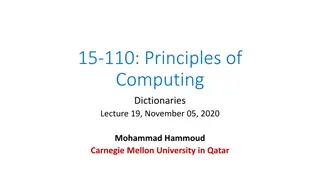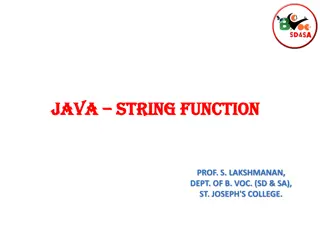Understanding Dictionaries in Python
Dictionaries in Python allow storing elements with keys of various hashable types and values of any data type. Keys must be unique, but values can be duplicated. Dictionaries cannot be concatenated but can be nested. When passed to a function, dictionaries exhibit pass-by-reference behavior due to t
2 views • 14 slides
Understanding Dictionaries in Python
Dictionaries in Python allow you to store elements with keys of any type and values of any type. They can contain any and different types of elements, have unique keys but can have duplicate values, cannot be concatenated or repeated, can be nested, and are mutable like lists. Dictionaries can be it
0 views • 13 slides
Rust References and Memory Safety in System Software Development
In Rust programming, references play a crucial role in ensuring memory safety and concurrency. Understanding concepts like owning pointers, shared vs. mutable access, working with references, and reference handling is vital for developing robust and secure system software in Rust. The language enfor
0 views • 9 slides
Understanding Lists in Python: A Comprehensive Guide
Lists in Python are versatile and essential data structures that allow you to store and manipulate ordered sequences of elements. They are mutable, meaning that you can modify their contents after creation. This guide covers the basics of lists, accessing elements, mutability, and common operations
0 views • 13 slides
Understanding Java String and StringBuffer: Immutable vs Mutable
Strings in Java are immutable sequence of characters, while StringBuffer provides mutable string objects. Learn about creating, manipulating, and comparing strings in Java programming. Explore the differences between immutable strings and mutable string buffers, and how to concatenate strings effect
0 views • 35 slides




